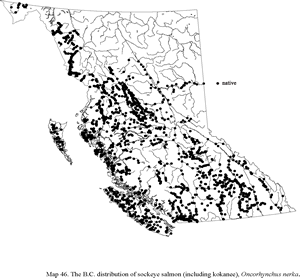Dorsal spines (total): 0; Dorsal soft rays (total): 11 - 16; Anal spines: 0; Anal soft rays: 13 - 18; Vertebrae: 56 - 67. Both the sockeye and the kokanee are distinguished by the long, fine, serrated, closely spaced gill rakers on the first arch that number between 30 and 40, and by its lack of definite spot on the back and tail (Ref. 27547). Body fusiform, streamlined, laterally compressed, body depth moderate, slightly deeper in breeding males (Ref. 6885). Head bluntly pointed, conical, eye rather small, position variable with sex and condition; snout rather pointed (Ref. 6885). Lateral line straight (Ref. 27547). Pelvic fins with axillary process; caudal emarginate (Ref. 27547). Pre-spawning fish are dark steel blue to greenish blue on the head and back, silvery on the sides and white to silvery on the belly; no definite spots on the back, although some individuals may have dark speckling and irregular marks on the dorsal fin (Ref. 27547). At spawning, the head of the males becomes bright to olive green, with black on the snout and upper jaw; the adipose and anal fins turn red and the paired fins and tail generally become grayish to green or dark; females are generally less brilliantly colored than males (Ref. 27547). Various populations may show less brilliant colors, and a few turn dull green to yellowish, with little if any red (Ref. 27547).
Source: FishBase. Page, L.M. and B.M. Burr 1991 A field guide to freshwater fishes of North America north of Mexico. Houghton Mifflin Company, Boston. 432 p.
